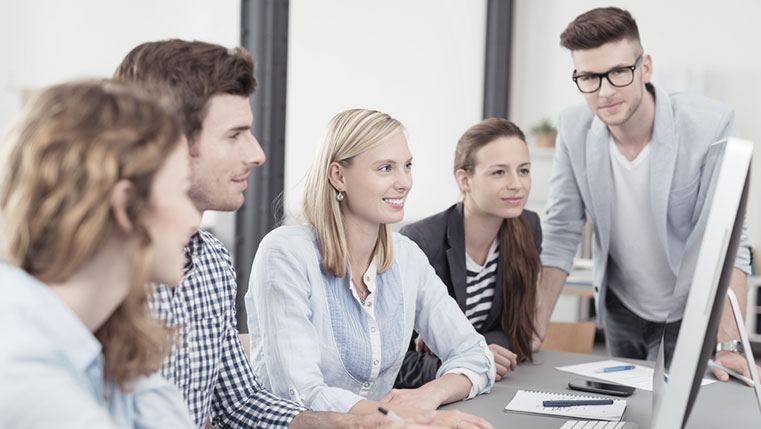How to Design Collaborative Learning for the Hybrid Workforce

The future is hybrid – that much became evident when the pandemic pushed us to work remotely. According to a Gallup survey, 53% of people expect a hybrid work arrangement, while 24% want to work remotely. Hence it is safe to assume that a hybrid workspace will be a permanent reality, and you need to plan accordingly.
→ Download Now: Rapid eLearning — The 4 Rs for Corporate Training Success
There are obvious concerns regarding collaboration and communication in hybrid workspaces. Thankfully, technological tools and integration can solve that problem to a large extent, preventing operational issues. However, training and learning aren’t as straightforward.
How to Design Collaborative Learning for the Hybrid Workforce?
Here are a few factors that you must consider:
- Establish Dedicated Areas for Collaborative Learning
- Shift to eLearning to Establish Balance
- Use Technology to Facilitate Collaborative Learning
- Establish Feedback System for Improvements
You will need to study and implement the concepts of collaborative learning to prevent knowledge and skill gaps between team members and improve performance levels. This blog will explain why collaborative learning is critical and the steps you must take to design an effective model.
Why You Need Collaborative Learning for a Hybrid Workforce
Collaborative learning is the process of learning together with other people. That is the simplest form of the concept, but it evolves once you consider specific situations. For example, collaborative learning for hybrid workspaces involves learning in a team that’s split up between onsite and remote employees.
Explore the Basics of Instructional Design to Make Sure eLearning Courses Stand Out!
While collaborative learning for the hybrid workspace requires more effort, it is worth it. Following are core reasons why collaborative learning is beneficial for a hybrid workplace:
1. Higher Flexibility and Adaptability
Hybrid workspaces existed before, but they were less common, and organizations barely accommodated them. However, incorporating them has shown surprisingly good results. Learning in such environments makes people more flexible and increases their adaptability.
They know the team is split, so they formulate creative strategies to connect with each other and boost their learning. This attitude also facilitates their performance by adapting the learning to routine coordination and collaboration.
2. The Structure is Optimized to Maximize Learning
Collaborative learning pays extra attention to facilitating the learning process. Instructors, tools, and course structures are adjusted according to the hybrid workforce model to ensure everyone learns at the same pace. It typically involves instruction, self-learning, and group work, so there is ample opportunity to repeat the lesson until it becomes firmly established.
The hybrid workforce can benefit from the blended learning approach since it can meet the demands of learners at different stages of their training. The result-based training paradigm of blended learning assists in identifying each learner’s performance and tailoring their instruction accordingly.
Hence, trainees often get better results in the collaborative learning format than in the regular one.
3. Gets People Accustomed to the Hybrid Workspace Model
Despite the popularity, organizations and employees will take time to adjust to the new hybrid workplace model. They have primarily been working entirely onsite or remotely; therefore, it will take some time to become accustomed to the new dynamic.
In that way, collaborative learning is an excellent opportunity. When designed for hybrid workspaces, this learning format creates an optimal communication structure for the team.
4. Encourages Continuous Learning
One of the best perks of collaborative learning for a hybrid workforce is that it promotes continuous learning. The practice eases team communication and makes it simpler to connect to brainstorm, share ideas, and work on solutions.
This arrangement has been exceedingly beneficial, especially in a market that changes rapidly due to quick advancement.
A Guide to Designing Collaborative Learning for the Hybrid Workforce
The above mentioned advantages make it evident that well-designed collaborative learning models suit hybrid workforces. The next step is to design a successful model for this process. Below are the primary elements that can help you create an effective learning environment:
1. Establish Dedicated Areas for Collaborative Learning
Firstly, you’ll need to allocate designated areas for collaborative learning that can facilitate onsite and remote employees. The best solution is to work with the IT department to choose the relevant rooms with the technical support to encourage such an atmosphere.
Overall, the rooms should have space for physical seating and screens showing remotely connected employees. The audio system should be well-integrated, allowing remote employees to participate equally in the discussion and learning process.
Above all, there must not be any connectivity issues lest they disrupt the class and cause remote trainees to lose out on the training process.
2. Shift to eLearning to Establish Balance
eLearning is the most suitable learning format for hybrid teams because it equally facilitates remote and onsite employees. There are several formats within eLearning, so you can choose the best one depending on the type of training you are conducting.
- Microlearning
- Gamification
- Mobile Learning
- Virtual Reality
Of course, you’ll need training experts with the experience to design training modules to optimize knowledge retention and other benefits. This mode of learning is also beneficial because it provides data. Hence, you’ll have an objective view of the difference in effectiveness for onsite and remote teams and make necessary changes.
3. Use Technology to Facilitate Collaborative Learning
Hybrid work is impossible without technology, especially in this day and age. However, the technology required for operational cooperation differs from the one necessary for collaborative learning. Your job is to consult with your IT and HR teams, highlight optimal learning technologies and purchase them for your employees.
The more advanced and adaptable the equipment, the more helpful it will remain in the long run.
4. Establish Feedback System for Improvements
Lastly, create a practical and objective feedback system to allow employees to rate the training arrangements. This system will help you understand employees’ concerns and try to facilitate them if possible.
It will make the employees feel valued, and their honest opinion will be instrumental in finalizing training sessions with maximum knowledge retention.
Some Additional Tips
The guide will help organize optimal training that’s enjoyable and furthers the relationship between team members. But you can do more to obtain your objectives. Below are some tips to help you enhance your results:
1. Organize Onboarding Sessions
Firstly, your employees need adjustment to become accustomed to the new setting. Organize onboarding sessions to let them know how the company will operate and how training will happen. The more they know about the situation, the better they’ll be able to cope with the changes.
2. Organize Virtual Team Meets
Some of your team members may be working remotely, but you shouldn’t let that affect the overall culture and teamwork dynamics. Arrange virtual team meets to ensure remote and onsite employees have ample time to brainstorm and talk casually.
They might not have the same schedules, so It is better to ensure they spend time with each other to develop a smooth working relationship.
3. Keep Communication Channels Open
Team leaders play a critical role in establishing collaborative learning for hybrid workplaces. It’s a new setup, so there is bound to be anxiety, confusion, and apprehension. Your part is to keep communication channels open and encourage your team to discuss professional concerns with you. The more you know about their grievance, the better you’ll respond to them and make necessary adjustments to dispel concerns.
4. Conduct Periodic Training Audits
Lastly, all transformations require routine audits to work. Please arrange for your training system to get periodic audits during its initial launch phases. The goal is to analyze the training effectiveness and make changes where necessary.
Final Thoughts
In a nutshell, assigning dedicated areas, shifting to eLearning, optimizing technology, and obtaining feedback are the top elements of collaborative learning for a hybrid workforce. You’ll need to work closely with the HR and IT teams to organize a setup that fulfills your training needs.
For the hybrid workforce, rapid eLearning plays a critical role in delivering uninterrupted training. It is now essential for you to become familiar with the 4Rs of Rapid eLearning and use them into your training initiatives.





